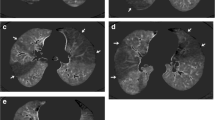Abstract
Amiodarone (AD)-induced pulmonary toxicity is one of the major complications of long-term AD therapy. Technetium-99m-labeled D,L-hexamethylpropylene amine oxime (Tc-99m HMPAO) scintigraphy has been used to assess lung injury. We designed this study to clarify lung uptake changes of Tc-99m HMPAO using low doses of AD (5 mg/kg/day) during long-term therapy in a rabbit model. Group 1 consisted of 7 rabbits fed with AD by gavage for 6 months. To investigate the effect of ketamine on Tc-99m HMPAO uptake, 5 rabbits were included in Group 2 as a control group. Tc-99m HMPAO scintigraphy was performed in both Group 1 and Group 2 at baseline and after 2, 4, 6, 8, and 12 weeks of AD intake. After 16, 20, and 24 weeks of drug intake, Tc-99m HMPAO scintigraphy was repeated only in group 1. One-min anterior images were acquired 30 min after the injection of 37 MBq of Tc-99m HMPAO. For semiquantitative evaluation, the mean count values were obtained and lung/background and liver/background ratios were calculated. Histopathologic evaluation was performed. No increase in lung and liver uptake of Tc-99m HMPAO was found 2, 4, 6, 8, and 12 weeks after drug intake. There was no significant increase in L/B and H/B ratios of Tc-99m HMPAO in Group 1 compared with Group 2. Both scintigraphic studies and histopathologic examinations showed nonspecific changes. Longitudinal studies investigating Tc-99m HMPAO lung uptake may be planned in patients carrying risk factors for AD-induced lung toxicity.

Similar content being viewed by others
References
Braunwald E (1997) Heart Disease. A Textbook of Cardiovascular Medicine, 5th ed. W.B. Saunders, Philadelphia, pp 613–615
Camus P, Martin WJ, Rosenow EC (2004) Amiodarone pulmonary toxicity. Clin Chest Med 25:65–75
Capa Kaya G, Bekis R, Kirimca F, et al. (2001) Use of technetium-99m HMPAO scintigraphy for the detection of amiodarone lung toxicity in a rabbit model. Eur J Nucl Med 28:346–350
Chang C-H, Wu H-C, Tsai J-JP, et al. (2003) Usefulness of technetium-99m hexamethylpropylene amime oxime lung scan to detect subclinical lung injury in patients with chronic renal failure. Lung 181:97–101
Cooper JAD, White DA, Matthay RA (1986) Drug-induced pulmonary disease. Part 2: noncytotoxic drugs. Am Rev Respir Dis 133:488–505
Dirlik A, Erinc R, Ozcan Z, et al. (2002) Technetium-99m-DTPA aerosol scintigraphy in amiodarone-induced pulmonary toxicity in comparison with Ga-67 scintigraphy. Ann Nucl Med 16:477–481
Durak H, Kilinc O, Ertay T, et al. (2003) Tc-99m-HMPAO uptake by bronchoalveolar cells. AnnNucl Med 17:107–113
Durmus-Altun G, Altun A, Sami Salihoglu Y, et al. (2004) Value of technetium-99m diethyltriamine pentaaceticacid radioaerosol inhalation lung scintigraphy for the stage of amiodarone-induced pulmonary toxicity. Int J Cardiol 95:193–197
Evans SJ, Myers M, Zaher J, et al. (1992) High dose oral amiodarone loading: Electrophysiologic effects and clinical tolerance. J Am Coll Cardiol 19:169–173
Gunaydin B, Karadenizli Y, Babacan A, et al. (1997) Pulmonary microvascular injury following general anesthesia with volatile anesthetics–halothane and isoflurane: a comparative clinical and experimental study. Respir Med 91:351–360
Hardman JG, Limbird LE (2001) Goodman & Gilman’s The Pharmacological Basis of Therapeutics. McGraw-Hill, New York, pp 953–957
Hilbert H, Mohsenin V (1996) Adaptation of lung antioxidants to cigarette smoking in humans. Chest 110:916–920
Hilleman D, Miller MA, Parker R, et al. (1998) Optimal management of amiodarone therapy: efficacy and side effects. Pharmacotherapy 18:1388–1458
Hung C-J, Liu F-Y, Shaiu Y-C, et al. (2003) Assessing transient pulmonary injury induced by volatile anesthetics by increased lung uptake of technetium-99m hexamethylpropylene amimie oxime. Lung 181:1–7
Kalbfieisch SJ, Williamson B, Man KC, et al. (1993) Prospective, randomized comparison of conventional and high dose loading regimens of amiodarone in the treatment of ventricular tachycardia. J Am Coll Cardiol 22:1723–1729
Kim SG, Mannino MM, Chou R, et al. (1992) Rapid suppression of spontaneous ventricular arrhythmias during oral amiodarone loading. Ann Intern Med 117:197–201
Latorre G, Lucas I, Herrero JI, et al. (1999) Severe hepatotoxicity caused by amiodarone: description of a case. Rev Med Univ Navarra 43:86–91
Meyers JL (1997) Pathology of drug-induced lung disease. In: Katzenstein AA, Askin FB (eds) Katzenstein and Askin’s surgical pathology of non-neoplastic lung disease Vol 4. W.B. Saunders, Philadelphia, pp 81–111
Roca J, Heras M, Rodriguez-Roisin R, et al. (1992) Pulmonary complications after long term amiodarone treatment. Thorax 47:372–376
Rossi SE, Erasmus JJ, McAdams HP, et al. (2000) Pulmonary drug toxicity: radiologic and pathologic manifestations. Radiographics 20:1245–1259
Rotmensch HH, Liron M, Tupilsky M, et al. (1980) Possible association of pneumonitis with amiodarone therapy. Am Heart J 100:412–413
Shih WJ, Gruenwald F, Biersack HJ, et al. (1991) Tc-99m HMPAO diffuse pulmonary uptake demonstrated in cigarette smokers. Clin Nucl Med 16:668–672
Shih WJ, Rehm SR, Gruenwald F, et al. (1993) Lung uptake of Tc-99m HMPAO in cigarette smokers expressed by lung/liver activity ratio. Clin Nucl Med 18:227–230
Spaniol M, Bracher R, Ha HR, et al. (2001) Toxicity of amiodarone and amiodarone analogues on isolated rat liver mitochondria. Hepatology 35:628–636
Suga K, Uchisako, Nishigauchi K, et al. (1994) Technetium-99m-HMPAO as a marker of chemical and irradiation lung injury: experimental and clinical investigations. J Nucl Med 35:1520–1527
Summitt J, Morady F, Kadish A (1992) A comparison of standard and high-dose regimens for the initiation of amiodarone therapy. Am Heart J 124:366–373
Uchisako H (1993) Evaluation of 99m Tc-HMPAO scintigraphy for irradiated lung in rabbits: detection of pulmonary microvascular injury. Nippon Igaku Hoshasen Gakkai Zasshi 53:835–846
Ulrik CS, Backer V, Aldlershvile J, et al. (1992) Serial pulmonary function tests in patients treated with low-dose amiodarone. Am Heart J 123:1550–1554
Weinberg BA, Miles WM, Klein LS, et al. (1993) Five-year follow-up of 589 patients treated with amiodarone. Am Heart J 125:109–120
Zhu YY, Botninick E, Dae M, et al. (1988) Gallium lung scintigraphy in amiodarone lung toxicity. Chest 93:1126–1131
Author information
Authors and Affiliations
Corresponding author
Rights and permissions
About this article
Cite this article
Kaya, G.C., Ertay, T., Tuna, B. et al. Technetium-99m Hexamethylpropylene Amine Oxime Lung Scintigraphy Findings in Low-Dose Amiodarone Therapy. Lung 184, 57–61 (2006). https://doi.org/10.1007/s00408-005-2562-3
Accepted:
Issue Date:
DOI: https://doi.org/10.1007/s00408-005-2562-3




